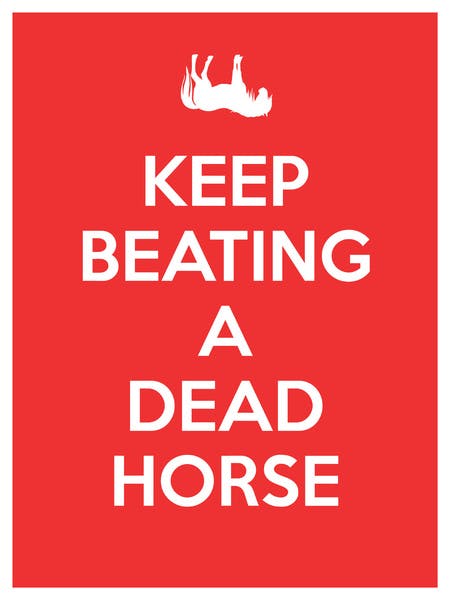Companies have all kinds of ways to react to bad business situations — blame others in the company, blame competitors, blame the markets, blame each other, etc. As you will see, denial probably plays the biggest part.
You’ve undoubtedly heard the term, “flogging a dead horse.” While the term is generally applied to discussing a topic to excess with no results forthcoming, it can also apply to management.
Vijay Govindarajan is Professor of International Business and director of the Tuck Center for Global Leadership at Dartmouth College. BusinessWeek, Forbes and The New York Times all rate him in the top 10 professors of business strategy. Govindarajan says that companies wanting to be strategic need to follow these three actions:
- = Manage the present;
- = Selectively abandon the past;
- = Create the future.
Abandoning the past
No. 2 is what this article is about — selectively abandoning the past. A lot of the past is relevant for the future. But, first a company has to understand what is relevant and what is irrelevant, and then have the courage to forget things that are irrelevant.
Top management finds it most difficult to “selectively abandon” irrelevant things because they have led to the company’s success. Top management defends them. They say these things — or these dead horses — are really relevant because:
- They were created by them.
- They must be valid because they have worked a long time and served the company well.
- They are an entrenched part of the company’s culture.
I thought I would use some examples to hopefully make some points about how management may typically react to denying the horse is dead.
When companies deny that the horse is dead
There are 10 of them. Like David Letterman’s Top 10 countdown, this article will include No. 10 through No. 6. My next article will continue with No. 5 to … (drum roll) No. 1.
10. — Whip the horse a little harder. When management has a particular way of doing something, and they find that all of a sudden it doesn’t work anymore, their first reaction is denial. So, they try the same method again and again. Who was it that said, “Doing the same thing over and over again and expecting different results is the definition of insanity”?
9. — Change the rider. If the same method, model, and technique doesn’t work after trying it a number of times and still coming up empty, upper management may decide there is something wrong with the person leading the “charge.” They may decide to replace him/her in hopes that if a new person takes responsibility, it will solve the problem and things will return to normal.
8. — Harness several dead horses together for increased speed. If frustration continues with no resolution to the problem, top management may decide to make a team of talent responsible for success, thinking that a combination of people will be able to accomplish what a single person could not do (and in less time).
7. — Emulate the best practices of companies riding dead horses. If the problem is still not resolved, top management may decide to look at the competition to see how they accomplish their goals. After looking at several of their competitors, they may come up with a “best practices” model. They decide this model should be used in resolving their problem — regardless of whether the companies reviewed have the same business strategies or not. All of a sudden, “best practices” becomes the company mantra and everyone has to march to the same tune. Of course, they cannot understand why implementing these best practices doesn’t resolve the dead horse problem.
6. — Proclaim that it’s cheaper to feed a dead horse. Management looks at costs and declares that doing the same thing over and over at least saves money. It is less costly, carries lower overhead, and therefore, contributes substantially more to the bottom line of the economy than do some other horses.
What to look for in your company
Perhaps some of you have seen some of these “dead horses” in your company? You might want to look for:
- Projects that make no more sense to pursue — they may have been great when started — but now they are just meaningless.
- The tenth offer to a potential client who, for whatever reason, just doesn’t want to do business with your company.
- The “innovative” strategy, model, etc. that costs your company a fortune and that everyone knows is going nowhere — and nobody dares to say anything or question why.
I hope you enjoy these. The rest of the list — No. 5 through No. 1 — will be in my next TLNT article.
